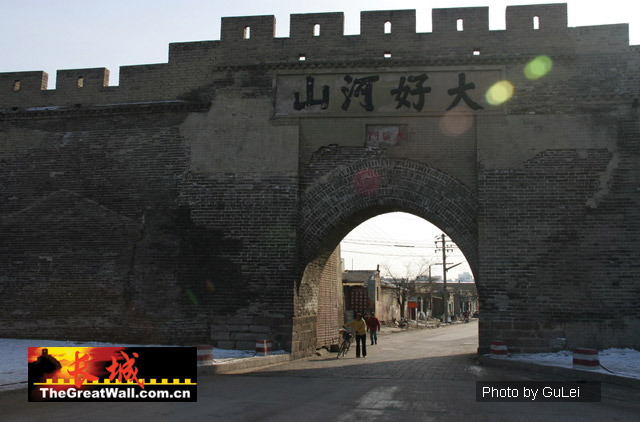The Zhangjiakou section of the Great Wall.

The Great Wall in Zhangjiakou City was built during the Ming Dynasty (1368-1644) as a defensive line along northern Beijing. Historically, Zhangjiakou (originally belonged to Xuanfu Garrison) and Datong areas were the battle grounds where most wars took place. According to statistics, over 50 famous wars and fights occurred in Zhangjiakou and more than 200 sites of ancient battle fields, fortresses and army headquarters were found.
To the north of Zhangjiakou city proper stands Dajingmen (Gate to the Great Territory).Located between the towering East and West Taiping Mountains, Dajingmen was built in 1644,the year the Qing Dynasty extended its rule south of the Great Wall. Its foundation was built of stone slabs, and the body of brick. It is 12 m high, with a broad platform at the top. The 100-m-long brick wall west of Dajingmen has a three-m-wide horse track on the top, leading to West Taiping Mountain.
The wall zigzags along the mountains on the east and west sides of Dajingmen. This is part of the Ming Dynasty Outer Great Wall. In order to ward off incursions by nomadic tribes, the Ming dynasty spent over 80 years renovating the old Qin, Northern Wei and Northern Qi walls, and constructing new sections. Along with the Inner Great Wall containing the Badaling section in Beijing, the Outer Great Wall served as an important shield for the capital. Inside the Dajingmen area, at intervals of 200-300 m, are beacon towers, testifying to the frequency of attacks on this section of the Great Wall.
In February 1697, following a victory here over invading Mongolians by Qing troops led by Emperor Kangxi in person, the local people asked scholar Zhang Zizhong to write an inscription meaning "Both Sides of the Great Wall Have Been United," and had them carved on a prominent cliff outside Dajingmen.
On his way back to the capital, the emperor arrived at Dajingmen in the middle of the night,only to find that the gate closed. The guards refused to open it, and the emperor had to spend the night outside the pass. Later, the Reclining Dragon (indicating the resting emperor) Pavilion was built to commemorate this incident.
The inscription on the lintel of the Dajingmen gate, meaning "Beautiful Mountains and Rivers," was written in 1927 by Gao Weiyue, governor of the Chahar region. The inscription, in bold, vigorous brushwork, and the inscription "Both Sides of the Great Wall Have Been United" on the cliff set off each other wonderfully, adding a tinge of cultural charm to the magnificent pass.
Dajingmen is an eyewitness to the history of Zhangjiakou. It has seen the rise and fall,prosperity and decline of ancient China's feudal society as well as the historical changes in the city. It has become the symbol of Zhangjiakou, and the local people are proud of it.
(Photograph : Gu Lei) |

